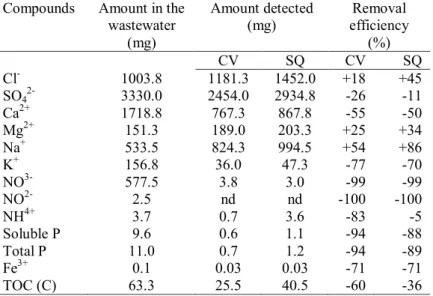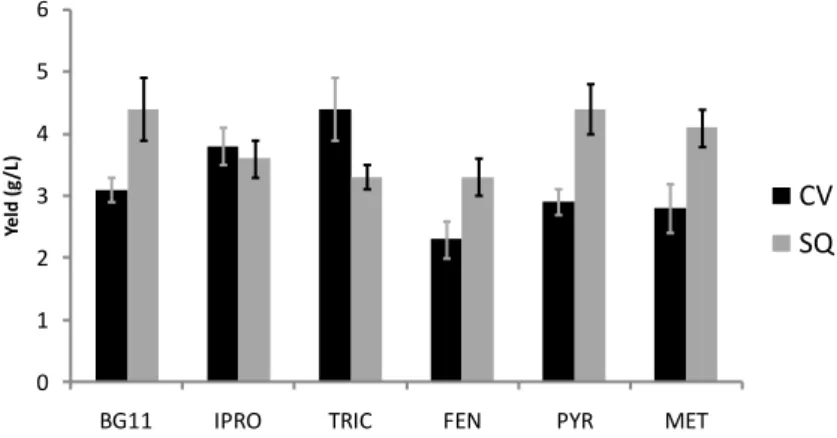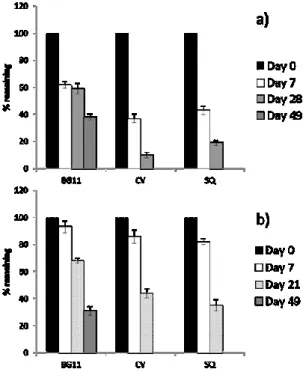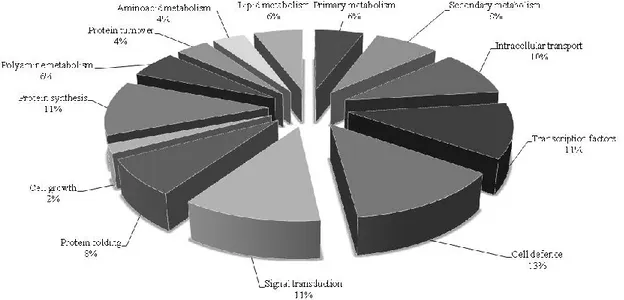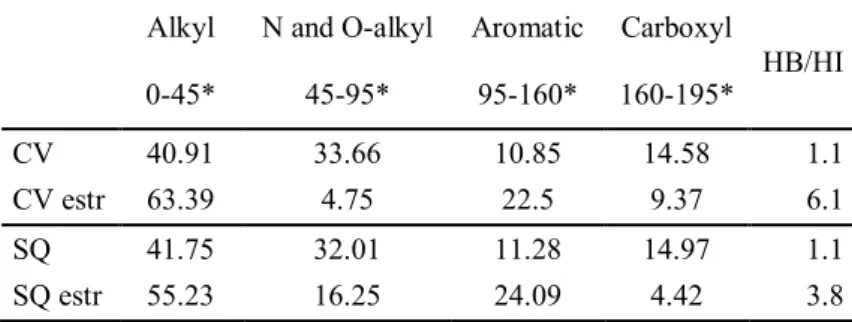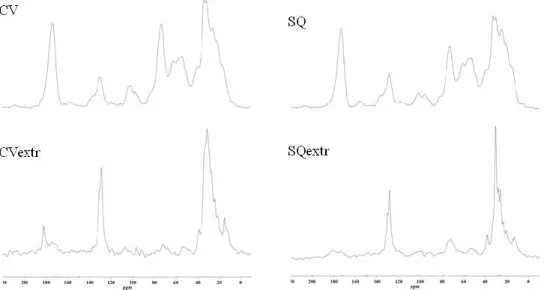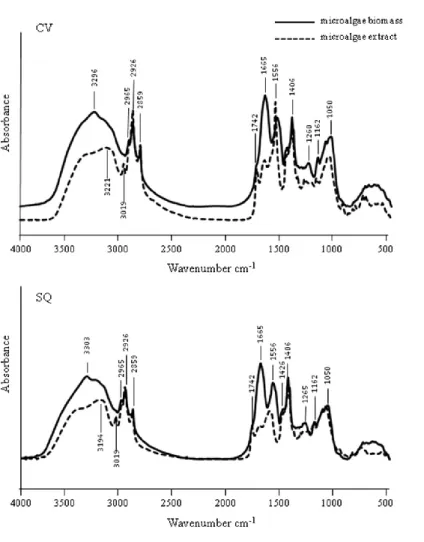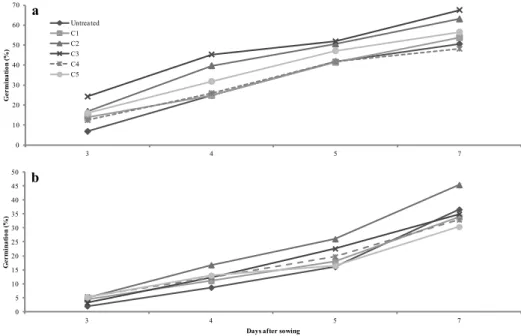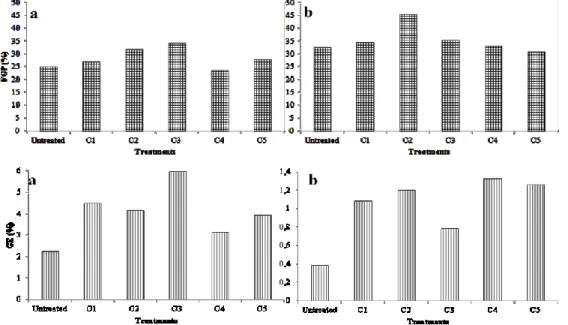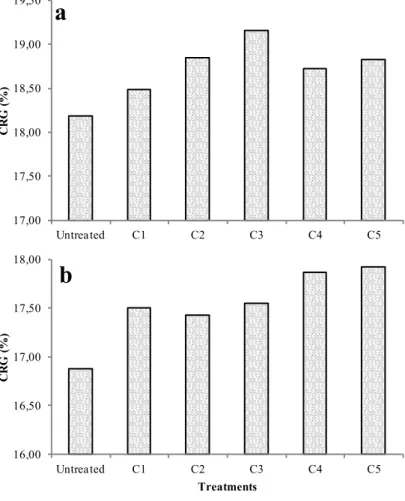UNIVERSITÀ DEGLI STUDI DI CATANIA
Ph.D. course in
AGRICULTURAL, FOOD AND ENVIRONMENTAL SCIENCE
XXX Cycle
Chlorella vulgaris and Scenedesmus quadricauda:
diversified applications for environmental and agricultural systems
Valeria Barone
Advisor:
Prof. Andrea Baglieri Coordinator:
Prof. Cherubino Leonardi
Index Abstract 1 Sommario 2 Foreword 4 CHAPTER I 12
1.
Introduction 132.
Materials and methods 162.1 Microalgae and wastewater 16
2.2 Wastewater decontamination test 17
2.3 Purification test for water containing agrochemicals 19
2.4 Determination of growth rate 21
2.5 Determination of agrochemicals 21
3.
Results and discussion 223.1 Wastewater decontamination test 22
3.2 Purification test for water containing agrochemicals 28
CHAPTER II 35
1. Introduction 36
2. Materials and methods 40
2.1 Preparation of microalgal extracts 40
2.2 Chemical, Spectroscopic and biochemical characterization of microalgal extracts 41
2.3 Bioassay for germination test in sugar beet 43
2.4 Bioassay for growth test in sugar beet 44
2.5 Gene expression analysis involved in growth of sugar beet 45
2.6 Bioassay for growth test of maize 46
2.7Physiological parameters and enzymatic activities in maize plants 50
2.8 Statistical analysis 51
3. Results and discussion 51
3.1 Chemical, Spectroscopic and biochemical characterization of microalgal extracts 51
3.2 Effect of C.vulgaris and S. quadricauda extracts on germina-
tion of sugar beet seed 60
3.3 Effect of C. vulgaris and S. quadricauda extracts on growth test in sugar beet 67
3.4 Gene expression involved in growth of sugar beet 67
3.5 Physiological parameters in maize plant 73
3.6 Enzymatic activities in maize plant 74
4. Conclusion
78
CHAPTER III 79
1. Introduction 80
2. Materials and methods 85
2.1 Experimental conditions and soil characterization 85
2.2 Fluorescein diacetate hydrolytic activity (FDA) 88
2.3 Dehydrogenase activity (DHA) 88
2.4 Acid and alkaline phosphomonoesterase activity (ACP, ALP) 88
2.5 Urease activity (URE) 89
2.6 Potential biochemical index of soil fertility (Mw) 89
2.7 Physiological parameters in tomato plants 90
2.8 Statistical analysis 90
3. Results and discussion 90
3.1 Fluorescein diacetate hydrolytic activity 90
3.2 Dehydrogenase activity 94
3.3 Acid and alkaline phosphomonoesterase activity 99
3.4 Urease activity 100
3.5 Potential biochemical index of soil fertility (Mw) 104
3.6 Physiological parameters in tomato plants 105
4. Conclusion 107
CHAPTER IV 108
1. Introduction 109
2. Materials and methods 112
2.1 Humic-like substances (HLs) 112
2.2 Microalgae culture and experimental conditions 112
2.4 Co-cultivation of microalgae and tomato plants 113
2.5 Statistical analysis 115
3. Results and discussion 115
3.1 Microalgal biomass and chlorophyll determination using HLs 115
3.2 Co-cultivation of microalgae and tomato plants 117
4. Conclusion 123
General considerations 125
1
Abstract
The topic of this thesis takes as its guiding principle the multifunctionality of microalgae, focusing on the use of Chlorella vulgaris and Scenedesmus quadricauda as decontaminants of agricultural wastewater, biostimulants for plant growth and for soil fertility. The main objectives of this thesis have been organized into four chapters. The first aim was to evaluate the removal capacity of microalgae with respect to organic and inorganic pollutants from agricultural wastewater. Secondly, the goal was to investigate the biostimulating effect of microalgae extracts on plants of agricultural interest, in particular sugar beet and maize. The third objective was to evaluate the effect of microalgal extracts and living cells on soil biochemical fertility. Finally, the last objective of this thesis was to evaluate the effects on growth of microalgae and tomato plants in a co-cultivation of C. vulgaris or S. quadricauda and tomato plants.
The results suggest that it is possible to use cultivation systems of both microalgae to purify agricultural wastewater which contains inorganic compounds and pesticides. The extracts prepared from C. vulgaris and S.quadricauda seem to be promising as biostimulants, both in promoting germination and in the early stages of plant growth in sugar beet. Furthermore, these microalgal extracts were shown to have positive effects on the physiological parameters under investigation of maize plants.
With respect to the biochemical fertility of soil, the results highlighted that metabolites of C. vulgaris and S. quadricauda may induce a higher soil biochemical fertility and simultaneously increase tomato plant growth.
2
Finally, the results suggested that the associated cultures of microalgae and tomato plants, in an hydroponic system, may be a cheap and useful way of simultaneously producing a greater quantity of microalgal biomass as well as improved tomato plant growth.
Sommario
La multifunzionalità delle microalghe è stato il filo conduttore di questa tesi, centrata sull’applicazione di Chlorella vulgaris e Scenedesmus quadricauda come decontaminanti delle acque reflue agricole, biostimolanti per la crescita delle piante e la fertilità del suolo. I principali obiettivi di questa tesi sono stati suddivisi in quattro capitoli. Il primo obiettivo è stato quello di valutare la capacità delle microalghe di rimuovere contaminanti organici ed inorganici dalle acque reflue agricole. In secondo luogo, lo scopo è stato quello di investigare l’effetto biostimolante di estratti microalgali su piante di interesse agricolo, in particolare la barbabietola da zucchero ed il mais. Successivamente, il terzo obiettivo è stato quello di valutare l’effetto di estratti microalgali e di cellule microalgali vive sulla fertilità biochimica del suolo. Infine, l’ultimo scopo di questa tesi è stato quello di determinare gli effetti sulla crescita di microalghe e di piante di pomodoro in una co-coltivazione di C. vulgaris o S. quadricauda e piante di pomodoro.
I risultati ottenuti suggeriscono che è possibile utilizzare entrambe le microalghe per purificare acque reflue provenienti dall’agricoltura, che contengono inquinanti inorganici ed agrofarmaci.
Gli estratti ottenuti da C. vulgaris e S. quadricauda sembrano essere promettenti come biostimolanti, sia per favorire la germinazione che i primi stadi di crescita di
3
piante di barbabietola da zucchero. Inoltre, questi estratti microalgali sembrano influenzare positivamente i parametri fisiologici investigati in piante di mais.
Riguardo alla fertilità del suolo, i risultati evidenziano che i metaboliti di C. vulgaris e S. quadricauda possono indurre una più alta fertilità biochimica del suolo e, simultaneamente, incrementare la crescita di piante di pomodoro.
Infine, i risultati suggeriscono che l’associazione di colture di microalghe e piante di pomodoro, in un sistema idroponico, può risultare utile ed economico per ottenere simultaneamente una più elevata biomassa microalgale, così come una maggiore crescita di piante di pomodoro.
4
Foreword
The definition of algae includes prokaryotic cyanobacteria and a large, diverse group of eukaryotic organisms, ranging from unicellular forms, like the genus Chlorella, to multicellular forms, like the genus Macrocystis.
Depending on their size, algae are divided into:
macroalgae, which are macroscopic multicellular organisms, generally associated with marine algae, that can reach lengths of 65 m;
microalgae, which are much smaller microscopic unicellular or multicellular organisms (from 1 to 50 µm).
Microalgae can be either autotrophic or heterotrophic and some species are mixotrophic.
An organism is autotrophic when it produces complex organic compounds (such as carbohydrates, fats and proteins) from simple substances present in its surroundings. Autotrophs can be photoautotrophs, using light as an energy source, or chemoautotrophs, utilizing electron donors from organic or inorganic sources as a source of energy.
Instead, an organism is heterotrophic when it is unable to synthetize organic compounds from inorganic substances, and therefore needs to feed itself on organic molecules produced by plants or animals. Heterotrophs can be further divided on the basis of the way in which they obtain energy; if the heterotroph uses light for energy, it is considered a photoheterotroph, while if it uses chemical energy, it is considered a chemoheterotroph.
Finally, mixotrophic organisms can use a mix of different sources to obtain energy and carbon, which means that these organisms cannot be classified as either autotrophs or heterotrophs. Autotrophic microalgae are all photoautotrophs. Photosynthesis is the process of
5 transferring light energy into chemical energy and converting CO2 and water into carbohydrates and oxygen,
which is quite similar in algae and higher plants (Richmond, 2004). The light reactions take place insides chloroplasts, on the thylakoid membranes. Chlorophyll and others pigments are subsumed on thylakoid in units of organization called photosystems. The main photosynthetic pigments are chlorophylls, carotenoids and phycobilins. There are several kinds of chlorophylls, that differ as regards some details of their molecular structure and specific absorption properties. Chlorophyll a is in all photosynthetic eukaryotes and cyanobacteria. Plants, green algae and euglenoid algae also include another pigment, chlorophyll b, that helps to extend the light interval in photosynthesis. Chlorophyll c substitutes chlorophyll b in some algae groups, the most important of which are brown algae and diatoms.
Photosynthesis produces carbohydrates that are used as carbon skeletons to form other organic compounds in algal cells.
Most algae are autotrophic, only a small part are heterotrophic such as Nitschia, of the diatom species. Heterotrophic algae are not photosynthetic and in order to grow they need organic matter to replace light as their substrate and energy (Kaplan et al., 1986). In these algae oxygen is supplied through aeration during respiration (Griffiths et al., 1960).
Mixotrophic microalgae can grow through both autotrophy and heterotrophy (Richmond, 2004). In mixotrophic algae CO2 and carbon can be assimilated simultaneously for their
growth, but photosynthesis and respiration can influence each other negatively.
The first study concerning mixotrophic microorganisms was that of Pascher (1917). Mixotrophs, which can offer
6 competitive advantages over phototrophs and heterotrophs, have been observed in various environments from oligotrophic habitats to eutrophic estuaries (Knowlton and Jones, 2000). However, it is only in recent years that mixotrophic algae have received greater attention from scientists worldwide. According to Chen (1996) and Zhang et al. (1999) the mixotrophic culture is a dual limiting process. Low light intensities or low organic carbon substrate concentrations and high light intensities or high carbon substrate concentrations can damage cell growth. Mixotrophic cultures have high rates of biomass production with photosynthetic metabolites (Lee and Lee, 2002).
Chlorella vulgaris is capable of combining both autotrophic
and heterotrophic techniques by performing photosynthesis as well as ingesting organic materials such as glucose (Liang et al., 2009; Yeh and Chang, 2012).
Microalgae have been subjected to various studies due to their great adaptability to different nutrient substrates and their ability to grow in different environmental conditions (Singh et al., 2005; Spolaore Cassan et al., 2006; Mata et al., 2010; Safi et al., 2014).
Indeed, when compared with terrestrial crops, microalgae have some advantages. For instance, microalgae are capable of all-year-round production, under favorable conditions, (Schenk et al., 2008) and there is no need to use to herbicides or pesticides during cultivation. Furthermore, they have high protein contents and the ability to synthesize an extraordinary variety of metabolites (Harun et al, 2010). Nowadays, there are numerous commercial applications for microalgae; they are a very interesting option for biofuel production; they can be used to enhance the nutritional value of human food and animal feed owing to their chemical composition; they play a crucial role in
7 aquaculture and they can be incorporated into cosmetics. Moreover, they are cultivated as a source of highly valuable molecules.
Microalgae for human nutrition are marketed in different forms such as tablets, capsules and liquids. They can be incorporated into pastas, snack foods, candy, gums, and beverages (Yamaguchi K., 1997; Liang S. et al., 2004). Microalgae have various possible health promoting effects: the alleviation of hyperlipidemia, suppression of hypertension, protection against renal failure, promoting the growth of intestinal Lactobacillus, and suppression of elevated serum glucose levels (Yamaguchi, 1997; Liang et al., 2004; Vilchez et al., 1997). For example, Chlorella is produced by more than 70 companies; its most important substance is β-1,3-glucan, which is an active immunostimolator, a free radical scavenger and can reduce blood lipids.
However, other effects have also been found: efficacy in cases of gastric ulcer, wounds and constipation, preventive action against atherosclerosis and hypercholesterolemia and antitumor action (Yamaguchi, 1997).
Microalgae are important for animals too, in fact, they can be incorporated into feed for different animals with 30% of microalgae production being sold for animal feed (Becker, 2004).
Additionally, microalgae can be a natural source of new compounds. This is because some microalgae live in complex habitats and are subject to extreme conditions, therefore, they must adapt rapidly to new environmental conditions to survive. As a result, they produce a great variety of metabolites that cannot be found in other organisms, which are generally hard to produce by chemical synthesis. It is possible to find bioactive compounds in
8 microalgae, which can be discovered due to the coexistence of these organisms in the natural aquatic community, where an inhibitory interaction occurs between producer and competitor in the same habitat (Lordan et al., 2011).
Moreover, they are a considerable source of protein and value-added compounds, which are of importance to the pharmaceutical and nutritional fields (Borowitzka and Borowitzka, 1992; Katircioglu et al., 2006).
It has been shown that cellular extracts, for example from
Chlorella vulgaris and Chlamydomonas pyrenoidosa, have
an antibacterial activity, like that observed in the growth medium of various unicellular algae (Singh et al., 2005). In addition it has been shown that it is possible to obtain a wide range of active antifungal activities in vitro from green-algae extracts, diatoms and dinoflagellates. Several strains of cyanobacteria are known for intracellular production and extracellular metabolites, with different biological activities (antibacterial, antimycotic and antiviral). Incubation temperature, soil culture pH, average constituents, incubation time and light intensity are important factors, that influence the production of antimicrobial agents (Spolaore Cassan et al., 2006).
Furthermore, microalgal extracts influence plant growth and development through a great number of substances (Ördög, 1999). These microrganisms benefit plants by supporting growth promoting regulators, vitamins, aminoacids, polypeptides, antibacterial and antifungal substances that exert a phytopathogen biocontrol and polymers such as exopolysaccharides that improve plant growth and productivity (de Mulè et al., 1999). Microalgae extracts are used to increase the growth parameters of many plants thanks to their biofertilization effect (Adam, 1999; Saffan, 2001). Shaaban (2001) investigated the effect of using the
9 aqueous extract of C. vulgaris as foliar feed on the status of nutrients, growth, and yield in wheat plants (Triticum
aestivum L.). This study found that a concentration of 50%
(v/v) extract in a single foliar spray (25 days after sowing) increased the growth yield and weight grain by 140% and 40%, respectively.
Furthermore, another study showed that C. vulgaris exerted an influence on the growth parameters and physiological responses of Lactuca sativa seeds germinated in culture medium containing microalgae for 3, 6, 9, 12 and 15 days (Faheed et al., 2008). The result was that the addition of C.
vulgaris to the culture medium or soil significantly
increased the fresh and dry weight of the seedlings as well as their pigment content. All the studies were carried out using the liquid extract of C. vulgaris as a biofertilizer for plant growth.
Unfortunately, literature concerning the application of microalgae in the agricultural field has focused prevalently on some species, while neglecting the potential of other microalgae, above all Scenedesmus quadricauda.
Aim and structure of the PhD study
Microalgae multifunctionality was the guiding principle of the present study. It focused on two microalgal species,
Chlorella vulgaris and Scenedesmus quadricauda.
The first species was chosen for its easy cultivation and because the organism, including its biochemistry, growth cycles and genetics, has been widely investigated (Kebelman, 2012). The second species was selected because it is ubiquitous in water environments and has often been selected for algae-based wastewater treatment (Chen, 2001; Omar, 2002; Ma et al., 2004; Awasthi and Rai, 2005; Mata et al., 2010). Additionally, the two algal species under
10 examination were chosen because of the differences in recognized size and shape (Bold, 1978).
Firstly, their use was aimed at reducing the environmental impact of agricultural wastewater, enriched by organic and inorganic pollutants, in order to ensure the proper management of the water cycle. However, this application led to the production of a waste by-product, algal biomass, for which literature reports many interesting applications. So, the by-product became a resource and not a waste product.
Human population growth and an unconditional use of chemical compounds has resulted in a need for sustainable agricultural practices. Among the different possible applications for microalgae, the use of microalgal biomass as a source of biostimulants can be considered as the most rational solution. Moreover, compared to the extensive literature that demonstrates the possibility of extracting biostimulants from seaweed, very few studies focus on microalgal extracts, making them more attractive.
Three crops were chosen to evaluate the biostimulating effect of microalgal substances. The first of these, Beta
vulgaris, was selected for its higher susceptibility to
environmental biotic and abiotic stresses, which strongly affect the world yield. The second, Zea mays, was chosen because it was a model plant and due to its economic importance worldwide. A further interesting plant to be investigated was the tomato, since it is considered a crop of relevant economic interest locally.
However, the use of a biostimulant cannot neglect the effect that this can have on the soil, especially as regards fertility. Biostimulants could be effective on plants, but on the other hand they could also be toxic to soil microorganisms, resulting in the reduction and / or destruction of soil fertility.
11 In addition, it was therefore also verified if the biostimulating effect on plants was exerted even when these substances were applied in a complex sistem as soil.
The final investigation regarded the possibility of co-cultivating microalgae and crops, which could benefit from micro-algal extracellular products with biostimulant effects. The main objectives of this thesis have been schematized in the following four sections:
Removal of organic and inorganic pollutants from agricultural wastewater by using Chlorella vulgaris and Scenedesmus quadricauda (Chapter I)
Studies on the biostimulating effect of Chlorella vulgaris and Scenedesmus quadricauda extracts on plants of agricultural interest (Chapter II)
Study on the effect of Chlorella vulgaris and
Scenedesmus quadricauda extracts on soil biochemical fertility (Chapter III)
Optimization of production: co-cultivation of
Chlorella vulgaris or Scenedesmus quadricauda and
12 CHAPTER I
Removal of organic and inorganic
pollutants from agricultural wastewater
by using Chlorella vulgaris and
Scenedesmus quadricauda
This chapter was pubblished as: Baglieri A., Sidella S., Barone V., Fragalà F., Silkina A., Negre M., Gennari M. (2016) Cultivating Chlorella vulgaris and Scenedesmus
quadricauda microalgae to degrade inorganic compounds and pesticides
13
1. Introduction
Agricultural activities produce a considerable quantity of wastewater containing high concentrations of inorganic and organic compounds, in much the same way as do civil and industrial activities. In order to dispose of this waste in soil or in surface water bodies, it must undergo a process of purification to reduce the concentration of chemical compounds that it contains to levels lower than those established by law (DM 31/2001 Italy).
The treatments used to decontaminate wastewaters can be mechanical, chemical, physical and biological. Studies are still in progress into innovative techniques, for exampleusing organo-clay to remove pesticides (Baglieri et al., 2009, 2013), a micelle-clay complex to reduce the concentration of drugs (Khalaf et al. 2013; Qurie et al. 2014) and numerous static and dynamic biological systems (Coppola et al., 2011; De Wilde et al., 2009).
One of the biological techniques under consideration is that of using microalgae to remove organic and inorganic compounds from wastewaters. Given that microalgae are particularly efficient in accumulating nutrients and heavy metals (de Bashan and Bashan, 2010) they can be used to reduce the concentration of contaminants. Moreover, purification plants can then provide agriculture and industry with algal biomass for use as an organic fertilizer or for the production of high-added-value derivatives (Rawat et al., 2011).
Many studies have been published regarding the capacity of microalgae to remove organic and inorganic compounds from wastewaters originating from food (Chi et al., 2011), industrial and agro-industrial processes (Chinnasamy et al., 2010; Mulbry et al., 2009; Rao et al., 2011) as well as from the civil and domestic sectors (Li et al., 2011; Martinez et
14 al., 2000). Komolafe et al. (2014) considered the possibility of growing several microalgae (Desmodesmus sp., Oscillatoria, Arthrospora) in water taken from a lagoon wastewater treatment plant with the aim of obtaining a biomass for the production of biodiesel and at the same time purifying the culture medium. The authors reported that treatment with the algae brought about a greater reduction in nutrients (nitrogen and phosphorus) than a conventional activated sludge system. All the microalgae used in the test reduced the concentration of total nitrogen, but to different degrees depending on the species (55.4–83.9 %). In the same experiment the concentration of orthophosphate also diminished but to a lesser degree than the nitrogen (30.1–
60.0 %).
Of the different microalgae proposed for use in treating wastewaters, studies on species of Chlorella, Ankistrodesmus and Scenedesmus have proved successful in
treating wastewaters from the olive oil and paper-making industries (Pinto et al., 2003; Tarlan et al., 2002). Zangh et al. (2008) reported that a Scendesmus genus microalgae was highly efficient in removing inorganic compounds from household effluents.
However, the efficiency of microalgae in removing different inorganic compounds varies. Lau et al. (1996) reported that purification with Chlorella vulgaris resulted in an 86% reduction in inorganic nitrogen and a 78% reduction in inorganic phosphates. Instead, Colak and Kaya (1988) reported that Chlorella sp. removed 50.2% and 85.7% of these two elements respectively from industrial wastewater. Rasoul-Amini et al. (2014) compared the ability of five strains of microalgae in removing nitrate and orthophosphate from batch cultures of urban wastewater. Their results indicated that Chlorella sp. (YG 1) was the
15 most efficacious in the removal of nitrogen (84.11 % in 2 weeks) with respect to the other strains, while
Chlamydomonas sp. (YG 04) and Chlamydomonas sp. (YG
05) brought about the greatest reduction in the concentration of phosphate (100 %).
Ruiz-Marin et al. (2010) carried out studies on the growth of C. vulgaris and Scenedesmus obliquus in urban wastewater and their capacity to reduce the concentration of N-NH4 and P-PO4 in the culture medium. Forty percent of nitrogen was removed from the control (no microalgae), but the reduction was greater when microalgae were present. In all the tests, after 40 h of treatment, S. obliquus proved the most efficient in removing ammonia (95.4–100 %) as compared to C.
vulgaris (65.6–80.0 %). The percentages of phosphorus
removed by the two microalgae were relatively similar (53.3–85.1 %).
As yet, very few studies have been carried out with regard to microalgae removing organic contaminants such as pesticides. Of these, Cai et al. (2007) studied the degradation of diclofop-methyl by algal cultures of C.
pyrenoidosa, C. vulgaris and S.obliquus, discovering that C. vulgaris was able to degrade more of the active ingredient
than C. pyrenoidosa and S. obliquus. Tsang et al. (1999) observed that species of Chlorella sp. were able to degrade trybutyltin into less toxic intermediate compounds, while Gao et al. (2011) studied the efficiency of the same species in removing nonylphenol, finding that 70% of the active ingredient was removed.
The wide variety of sometimes discordant data to be found in literature demonstrates how the capacity of microalgae to adsorb, degrade and remove nutritive and pollutant elements in general can vary according to the algal species used and
16 the chemical parameters of the wastewater to be treated (Komolafe et al., 2014; Cabanelas et al., 2013).
Aim and scope
The aim of this study was to evaluate the capacity of two microalgae species, Chlorella vulgaris and Scenedesmus
quadricauda, to remove organic and inorganic pollutants of
agricultural origin. Two particular case studies were considered: one relating to the growth of the two species in wastewater from a hydroponic greenhouse cultivation in order to evaluate the degree of removal of the main inorganic compounds; and the other regarding how the same species of algae were able to degrade five different active ingredients commonly used in agriculture for phytoiatric treatments.
2. Materials and methods
2.1 Microalgae and wastewater
Tests were carried out using two species of microalgae, C.
vulgaris and S. quadricauda, both supplied by Swansea
University (Wales, UK). The wastewater was a residue from the hydroponic cultivation of “cherry-type” tomatoes grown in a greenhouse (Noto, Siracusa, Italy). The wastewater was collected and its main chemical components analyzed: total organic carbon (TOC) (UNI EN 1484 1999); nitrates (NO3−)
and sulfates (SO42−) (UNI EN ISO 10304-1 2009); calcium
(Ca2+) and potassium (K+) (UNI EN ISO 14911 2001); and ammonia nitrogen (NH4+), nitrites (NO2−), soluble
phosphorus (sol. P), total phosphorus (tot. P), and iron in the form of Fe3+ (APHA, AWWA, WEF 2012). The chemical composition of the wastewater is shown in Table 1. The wastewater did not undergo any kind of treatment before the test.
17
Table 1. Chemical and biological composition of the greenhouse
wastewater.
Compounds Amount in the
wastewater (mg L-1) Cl- 365.0 SO42- 1200.0 Ca2+ 625.2 Mg2+ 55.1 Na+ 194.0 K+ 57.2 NO3- 210.0 NO2- 0.9 NH4+ 1.4 Soluble P 3.5 Total P 4.0 Fe3+ 0.04 TOC (C) 23.0
Escherichia coli (UFC/100 mL) 8
Salmonella Absent
2.2 Wastewater decontamination test
The growth apparatus was a plexiglass tank subdivided into nine compartments illuminated by a 3500-lx, average photon flux (PPF) 100-μmol m−2 s−1 light source (PHILIPS SON-T AGRO 400) with a 12-h photoperiod. Each compartment was fitted with a silicon tube with a terminal diffuser connected to a forced ventilation system.
The test was performed by placing 424 mg S. quadricauda or 388 mg C. vulgaris into 2000 mL of greenhouse wastewater or artificial medium (BG11) sterilized in an autoclave at 121 °C for 20 min. Table 2 shows the chemical composition of the BG11 medium. Each test was repeated three times. In alternate weeks, the quantity of water that had evaporated was restored by adding distilled water or the initial substrate (greenhouse wastewater or BG11). In total, 750 mL of greenhouse wastewater or BG11 and 750 mL of
18
distilled water were added. The microalgae were grown at room temperatures of between 25–30 °C. Every 7 days, 10 mL of algal suspension was sampled to determine the rate of growth.
Table 2. Chemical composition of BG11 medium.
In previous tests, it was shown that the two microalgae stopped growing after 49 days when they reached the stationary phase. For this reason, the 49th day was chosen as the final day of the test. At the end of the test, the suspension was carefully removed from each tank and centrifuged at 2500 rpm for 10 min. The supernatant was filtered using a Buchner system with WHATMAN fiberglass filters, then analyzed for the same parameters as were taken into consideration at the beginning of the test. In order to determine total algae production, the sedimentary pellet of algal biomass was oven-dried at 70 °C until constant weight was reached.
Component Conc. in final medium (mg
L-1) NaNO3 14.97 MgSO4 * 7H2O 74.93 K2HPO4 30.31 CaCl2 * 2H2O 36.02 Citric acid 6.00 Ferricammoniumcitrate 8.40 Na2EDTA 0.95 Na2CO3 20.04 H3BO3 0.06 MnSO4 * H2O 0.03 ZnSO4 * 7H2O 0.03 CuSO4 * 5H2O 0.01 (NH4)6Mn7O24 * 4H20 0.02
19
2.3 Purification test for water containing agrochemicals
A laboratory test was set up to determine whether C.
vulgaris and S. quadricauda were able to promote the
degradation of pyrimenthanil, methalaxyl, iprodione, and fenhexamid fungicides and triclopyr herbicide. These particular compounds were chosen because they are widely used in agriculture and can be considered to represent a much wider range of agrochemicals in that they all have different chemical-physical characteristics (Table 3).
Fifty milliliters of algal suspension, containing 75 mg of cells, and 150 mL of BG11 culture medium containing 5.5 ppm of active ingredient (Sigma-Aldrich, Milan, Italy; 99.0 % purity) were placed in 250-mL flasks, thereby obtaining a final pesticide concentration of 4 ppm.
Contemporarily, the flasks were prepared containing the active ingredients in a sterile substrate. Each test was replicated three times. The flasks were closed with a cotton plug, placed on a mechanical shaker, and illuminated by a light source at a power equal to 3500 lx and average photon flux (PPF) equal to 100 μmol m−2 s−1 (PHILIPS SON-T AGRO 400) with a 12-h photoperiod. Room temperature was maintained between 25 and 30 °C.
A sample was taken of the suspension (flasks with microalgae) and the solution (control in sterile BG11) as soon as the test began in order to determine zero time. Further, 10-mL samples of the suspension and solution were then taken at different times to determine the concentration of the compounds. Before each sampling, BG11 was added to compensate for the water lost through evaporation.
At the end of the test, the samples containing the microalgae were centrifuged at 2500 rpm for 10 min and the pellet was oven-dried at 70 °C until constant weight was reached. It was then weighed to measure the total biomass.
20 Table 3. Physical and chemical properties of the agrochemicals studied.
21
2.4 Determination of growth rate
Growth was measured on a weekly basis using a spectrophotometer (Jasco V-530 UV-Vis spectrophotometer) at a wavelength of 550 nm. The data were expressed in agreement with Vandamme et al. (2012) according to the following relation:
where:
Ig: the growth index;
Abs 550 T(x): absorbance of the 550 nm wavelength at time
x;
Abs550 T(0): absorbance of the 550 nm wavelength at time
0.
2.5 Determination of agrochemicals
Liquid chromatography (LC) was used to analyze the supernatant which was separated from the algal biomass by centrifugation at 3000 rpm for 15 min, to evaluate the variation in concentration of each agrochemical in the tests over time. Moreover, in order to evaluate how much active ingredient had been adsorbed by the algae by the end of the test, the whole of the biomass obtained was extracted by adding 100 mL of hexane then shaking for 30 min and centrifuging at 3000 rpm for 15 min. The supernatant was filtered over anhydrous sodium sulfate and transferred to a vacuum flask.
The whole process was repeated twice more with extraction times of 15 min. All the supernatants obtained were
22
collected together and subjected to vacuum evaporation using a Rotavapor (LABOROTA 4000, Heidolph, Milan, Italy). The dry residue was dissolved in 5 mL of acetonitrile and analyzed by LC.
The LC analyses were carried out using a Shimadzu Liquid Chromatograph Mod. LC-10 ADvp, fitted with a UV/vis detector, a 20-μL loop, and a SupelcoSil LC-18 column, eluted with a mobile phase consisting of water acidified to pH 3 with H3PO4 (40 %) and CH3CN (60 %). The analyses were carried out at a flow speed of 1 mL min−1; the wavelengths used for analyzing the active ingredients were equal to 220 nm (fenhexamid, iprodione, metalaxyl, and pyrimethanil) and 230 nm (triclopyr).
3. Results and discussion
3.1 Wastewater decontamination test
At the end of the test, about 25 % less algal biomass of both species was obtained from the greenhouse wastewater than from the control. In the greenhouse wastewater and BG11, the C. vulgaris biomass amounted to 3.75 g L−1 (corresponding to 67 mg L−1 day−1) and 5.15 g L−1 (corresponding to 92 mg L-1 day−1), respectively; in the greenhouse wastewater and BG11, the S. quadricauda biomass amounted to 3.65 and 5.69 g L−1 (corresponding to 65.18 and 101.68 mg L−1 day−1), respectively.
The yields were in agreement with data reported in literature. In particular, when treating digested animal manure with Chlorella sp., Wang et al. (Wang et al., 2010a,
b) obtained an 81.4-mg L−1 day−1 biomass. Data available in literature regarding Scenedesmus sp. indicate a biomass production that varies between 6 mg L−1 day−1 from agricultural livestock wastewater (Kim et al., 2007) to 120
23 mg L−1 day−1 obtained from artificial wastewater (Voltolina et al., 1999). Furthermore, Martinez et al. (2000) obtained a yield of 26 mg L−1 day−1 using S. obliquus to treat urban wastewater.
Up to the 49th day of the trial, there was an increase in the growth rate of C. vulgaris and S. quadricauda over time in both the growth mediums studied. At the end of the test, the growth rate in the experiments that had used greenhouse wastewater as the culture medium was greater for C.
vulgaris than for S. quadricauda. Although both species
adapted well to the greenhouse wastewater, both C. vulgaris and S. quadricauda achieved higher growth rates in the control (BG11) (Table 4), in agreement with Hultberg et al.
(2013) who observed a greater growth rate for C. vulgaris when cultivated in an artificial substrate as compared to when it was grown in residues from hydroponic cultivation. The initial composition of the greenhouse wastewater in which the algal species were grown was characterized by a higher quantity of nitrous and nitric nitrogen than ammonia nitrogen (211 mg L−1 of NO3− + NO2− and 1.36 mg L−1 of
NH4+). Total and soluble phosphorous were present in
quantities equal to 4 and 3.5 mg L−1, respectively. The parameter relating to the total organic carbon (TOC) was 23
mg L−1 (Table 1).
Table 5 reports the total quantity of the major compounds
present in the wastewater during the test, calculated on the basis of the further additions made (2000 mL + 750 mL).
The same table also shows the amount found in the wastewater at the end of the test and the difference between the two values expressed as a percentage.
With regard to the removal of inorganic compounds, both species in the study demonstrated an aptitude for
24 decontamination. The two algal species showed a preference for nitric nitrogen rather than ammonia nitrogen, contrary to what has been reported in literature where it appears that the microalgae prefer the ammonia type of nitrogen (Kim et al., 2010; Perez-Garcia et al., 2011).
According to a number of authors, if the assimilation of the ammonia type does not lead to a reduction reaction, then it is the most efficient from an energy point of view as it requires a smaller amount of energy in the organication process (Grobbelar, 2004; Maestrini et al., 1986; Wilhelm et al., 2006). Nevertheless, Sidney et al. (2011) showed that if there is a fairly low concentration of ammonia nitrogen in the cultural medium, then the microalgae tend to remove the nitric form.
Table 4. Growth index of C. vulgaris (CV) and S. quadricauda (SQ)
grown in BG11 medium and greenhouse wastewater.
Time
(days) Growth index (IG)
CV BG11 CV wastewater SQ BG11 wastewater SQ 0 0.0 0.0 0.0 0.0 6 1.9±0.2 3.2±0.3 3.2±0.2 3.0±0.2 14 4.9±0.3 6.8±0.4 9.0±0.6 5.3±0.4 21 11.6±1.3 7.7±0.7 14.2±1.4 12.7±0.8 28 16.1±1.1 9.9±1.0 15.3±1.7 15.2±1.4 35 19.7±2.3 14.9±1.7 17.6±0.8 17.4±0.9 42 22.6±2.0 17.3±1.2 27.5±2.2 18.3±1.8 49 34.8±3.1 26.2±2.8 32.7±3.9 20.6±1.4 56 32.0±2.5 21.9±1.8 27.5±1.7 19.4±1.2
25
In our case, while demonstrating a preference for the nitric forms (99 % removal), C. vulgaris also removed about 83 % of the ammonia nitrogen. On the contrary, S. quadricauda consumed about 99 % of the nitric nitrogen but only 5 % of the ammonia nitrogen.
Table 5. Total amount of the main compounds present in the
greenhouse wastewater throughout the test; total amount recorded at the end of the test; difference espressed in percentage. Nd = not detected. Standard deviation< 10%.
Compounds Amount in the wastewater (mg) Amount detected (mg) efficiency Removal (%) CV SQ CV SQ Cl- 1003.8 1181.3 1452.0 +18 +45 SO42- 3330.0 2454.0 2934.8 -26 -11 Ca2+ 1718.8 767.3 867.8 -55 -50 Mg2+ 151.3 189.0 203.3 +25 +34 Na+ 533.5 824.3 994.5 +54 +86 K+ 156.8 36.0 47.3 -77 -70 NO3- 577.5 3.8 3.0 -99 -99 NO2- 2.5 nd nd -100 -100 NH4+ 3.7 0.7 3.6 -83 -5 Soluble P 9.6 0.6 1.1 -94 -88 Total P 11.0 0.7 1.2 -94 -89 Fe3+ 0.1 0.03 0.03 -71 -71 TOC (C) 63.3 25.5 40.5 -60 -36
Franchino et al. (2013) evaluated the capacity of three different algal strains in an agro-zootechnical digestate and observed that C. vulgaris removed more ammonium than S.
quadricauda (99 and 83 %, respectively). On the contrary,
Gonzales et al. (1997) observed that Scenedesmus
26 ammonium from agro-industrial wastewater, even if only during the initial experimental phases. In our study, both the microalgae removed between 88 and 94% of phosphates. Nevertheless, C. vulgaris removed slightly more than S.
quadricauda, the respective values for the two species being
94 and 88–89 %. Removal of nitrogen and phosphate compounds by Scenedesmus spp. is further confirmed by data in literature provided by Di Termini et al. (2011) and Guo et al. (2013). These works report that algal species belonging to the Scenedesmus genus demonstrated an almost 100 % efficiency in removing nitrogen and
phosphate nutrients.
The two microalgae were also found to have exerted a positive effect on the reduction in sulfate concentrations, reducing the quantity by 26 and 11 % (C. vulgaris and S.
quadricauda, respectively). Both microalgae reduced the
concentration of iron by 71% while potassium went down by 77 % when C. vulgaris was present and 70 % when S.
quadricauda was present.
In the C. vulgaris cultures, the reduction in total organic carbon content was 60 %, while for S. quadricauda, the reduction was 36 %. Degradation of organic carbon by
microalgae is a process related to the heterotrophic/mixotrophic metabolism that they are able to assume in the absence of light and/or when CO2 is limited
(Perez-Garcia et al., 2011). One reason for the difference in removal rates observed when comparing the two species could be the fact that C. vulgaris had a higher rate of growth than S. quadricauda. Combres et al. (1994) reported that both C. vulgaris and S. obliquus are able to utilize organic
substances under both light and dark conditions. Studies on the mixotrophic and heterotrophic growths of some
27 microalgae performed by EL-Sheekh et al. (2012) showed that the addition of glucose and soluble organic products derived from wheat bran induced a good growth of C.
vulgaris and S. obliquus under both mixotrophic and
heterotrophic conditions. Nevertheless, mixotrophic conditions produced a better effect on the growth of the two microalgae, in particular C. vulgaris.
An increase was observed in some inorganic constituents such as chlorides, magnesium, and sodium. It seems evident that more of these elements were added than were consumed by the algae. Fodorpataki and Bartha (2004) found that cultures of Scenedesmus opoliensis can acclimate to a high salt concentration (0.5 M NaCl). Under these conditions, the rate of cell division shows only a moderate decrease. A higher tolerance was mainly expressed when high photon lux density is applied suggesting the role of light in supporting the energy demands of a protective mechanism against the abiotic stress. Talebi et al. (2013) demonstrated that among Chlorella species, C. vulgaris shows signs of adaptation to a high content of salinity. In fact, C. vulgaris survived at NaCl concentrations as high as 0.75 M. On the basis of the above, the concentration of salts, in particular NaCl, found of the medium at the end of the test, explains a slight decrease in the growth of the two microalgae. However, this decrease does not affect the purifying activities of C. vulgaris and S. quadricauda against many other compounds, in particular nitrogen and phosphorus which are of interest due to their role in the eutrophication of water bodies.
28
3.2 Purification test for water containing agrochemicals
The two species of algae used in the study grew well in the presence of all the active ingredients. As regards C.
vulgaris, a slight increase in yield was seen when iprodione
and triclopyr were present (21 and 42 %, respectively) while the presence of fenhexamid reduced microalgae production by 26 % as compared to the uninoculated control (3.1 g L−1). Pyrimethanil and metalaxyl brought about a reduction in yield of only 10 %, a result which was not statistically significant (Figure 1). 0 1 2 3 4 5 6
BG11 IPRO TRIC FEN PYR MET
Yel d (g /L ) CV SQ
Figure 1. Biomass production of C. vulgaris (CV) and S. quadricauda
(SQ) grown in BG11 medium not contaminated, added with metalaxyl (MET), fenhexamid (FEN), pyrimethanil (PYR), triclopyr (TRIC), and iprodione (IPRO). The bars indicate standard deviation (n = 3).
S. quadricauda grew more efficiently than C. vulgaris in
sterile BG11 (4.4 g L−1). Pyrimethanil did not influence the quantity of microalgae produced, while there was a reduction in yield of 7, 18, 25, and 25 % in the presence of
29
metalaxyl, iprodione, triclopyr, and fenhexamid, respectively (Figure 1).
Although in some cases the two microalgae showed signs of suffering from a slightly toxic effect, it appears reasonable to affirm that growth is possible in the presence of all the pesticides in the growth medium. The only published data available regard the effect of fenhexamid on Scenedesmus
subspicatus. It is reported that in a 72-h test carried out in
static conditions, the value of EC50 was >26.1 mg L−1, which the authors held to be of little toxicological interest
(Byrnes 2001).
The results of the pesticide degradation tests are shown in
Figure 2 and Figure 3.
The microalgae proved effective in all cases, but with noticeable differences depending on the added molecule. The test with metalaxyl provided the most interesting result because this molecule dissipated much more quickly in the presence of the microalgae than in the uninoculated control. In fact, 69 % of the added active ingredient was still found in the sterile medium 56 days from the start of the test, while the metalaxyl disappeared from the medium with the two microalgae only 14 days after inoculation (Figure 2). Metalaxyl is very stable to hydrolysis. Sharon and Edgington (1982) found 84% of the compound after 12 weeks of storage in water. Metalaxyl is also stable in sunlight since its absorption maximum is 196 nm (Sukul and Spiteller, 2000). The microalgae also accelerated dissipation of fenhexamid although to a lesser extent than metalaxyl. After 49 days, fenhexamid was no longer present in the medium with microalgae, while 52 % was still present in the uninoculated medium (Figure 3). Abbate et al. (2007) studied the degradation of fenhexamid in sterile buffer
30
solutions and in natural water. They reported that 101 days from the beginning of the test, 4 % of the active ingredient had been degraded at pH 4, 12% at pH 7, and 23% at pH 9. In natural water, 112 days after contamination, 80 % of the fenhexamid was recovered. These results indicate that this molecule presented a substantial resistance to hydrolysis but a positive correlation with pH. As the pH of the culture medium of C. vulgaris and S. quadricauda averaged 9.5, it is possible that the accelerated degradation of fenhexamid was partly due to the alkaline conditions of the medium. In the uninoculated test, as in the tests with microalgae, light
radiation may also have contributed to the degradation as it has been reported that fenhexamid might be subject to photo-degradation when exposed to solar radiation (Byrnes, 2001).
The dissipation of metalaxyl and fenhexamid occurred faster in the presence of C. vulgaris than S. quadricauda. This suggests that with equal conditions the presence of the microalgae was essential in determining the disappearance of the molecules from the aqueous solution. As regards iprodione and triclopyr, while the positive action of the two microalgae in the dissipation process appeared less pronounced, it was without doubt efficacious. This is probably due to the fact that these two molecules are more susceptible to abiotic degradation (Figure 3).
Iprodione degrades rapidly in alkaline solution. The DT50 values observed were 37 days, 1.1 days, and 21 min at pH 5, 7, and 9, respectively (Roberts and Hutson, 1998).
As the average value of the pH of the culture broth in the presence of iprodione was 9.2, the alkaline conditions caused by the growth of the microalgae may have
31 Figure 2. Dissipation of a pyrimethanil, b metalaxyl, and c fenhexamid
in culture medium inoculated with C. vulgaris (CV) and S. quadricauda (SQ) and in sterile medium (BG11). The error bars indicate standard deviation (n = 3).
32
accelerated the degradation process as compared to the control which had a pH of 7.9.
Triclopyr has little tendency to hydrolyze (DT50 = 270 days) (Linders et al., 1994). Cleveland and Holbrook (Claveland and Holbrook, 1992) investigated the hydrolysis of radio-labeled tricloyr in buffered distilled water at pH 5, 7, and 9. After 1 month, the parent compound represented 97.2 % of the activity remaining in the samples leading to the conclusion that hydrolysis would not be an important mechanism for the dissipation of triclopyr from an aqueous system. On the other hand, Green and Westerdahl (1993) stated that photolysis is the principal degradation pathway for triclopyr in aqueous solution. In river water, the half life of triclopyr was determined to be 1.3 days both in artificial and natural light (Woodburn et al., 1993).
On the basis of the above considerations, triclopyr degradation observed in our study was probably caused mainly by light radiation even if the two microalgae contributed to enhancing the rate of degradation independently of variations in the pH of the medium.
Pyrimethanyl behaved differently from the other pesticides, proving more resistant to dissipation in the presence of C.
vulgaris and S. quadricauda. Nevertheless, also in this case,
the two microalgae reduced the active ingredient content in solution as compared to the sterile control. This occurred principally in the presence of S. quadricauda which after 56 days growth reduced the pyrimethanil content of the initial dose, while in the sterile BG11 the residual content was 56
% (Figure 1). The pesticide extraction tests performed on
the biomass produced with organic solvent highlighted that there was no physical adsorption except in the case of pyrimethanil. In this case, extraction from the biomass with
33
organic solvent highlighted the proportion of active ingredient that was not present in solution.
A similar result was obtained by Bizaj et al. (2011) in liquid cultures containing Saccharomyces cerevisiae.
Figure 3. Dissipation of a iprodione and b triclopyr in culture medium
inoculated with C. vulgaris (CV) and S. quadricauda (SQ) and in sterile medium (BG11). The error bars indicate standard deviation (n = 3). In fact, they did not observe significant differences in the removal of pyrimethanil between viable and non-viable cells, concluding that pyrimethanil was not degraded by metabolically active cells.
34
It is therefore interesting to note that while in the sterile control the molecule was partially degraded, no degradation took place in the presence of the microalgae but there was a transfer from the liquid phase to the solid phase with a consequent risk of producing contaminated biomass. The degradation of pyrimethanil in the control samples could not have been due to hydrolysis because it has been reported that the compound is stable in sterile buffer solutions at pH 5, 7, and 9 (EFSA, 2006). In addition, pyrimethanil does not seem to undergo direct photolysis while it seems possible that it could be indirectly photodegraded in the presence of photosensitizers (EFSA, 2006).
On the other hand, in the tests involving the other active ingredients, the biomass did not contain any residues. In the case of fenhexamid, our result differs from that obtained by Bizaj et al. (2011), who found that fenhexamid, like pyrimethanil, was absorbed by S. cerevisiae cells.
The results from this study suggest that it is possible to use a
C. vulgaris and S. quadricauda cultivation system to purify
wastewater from farming which contains inorganic compounds and pesticides. There are numerous methods for cultivating microalgae (Sharma et al., 2011). However, a suitably modified open system, like the one described in the “Materials and methods” section, could be a simple, inexpensive, easy-to-use solution even for small farms.
35 CHAPTER II
Studies on the biostimulating effect of
Chlorella vulgaris and Scenedesmus
quadricauda extracts on plants of
agricultural interest
Part of the data in this chapter was pubblished as: Barone V., Baglieri A., Stevanato P., Broccanello C., Bertoldo G., Bertaggia M., Cagnin M., Pizzeghello D., Moliterni V.M.C., Mandolino G., Fornasier F., Squartini A., Nardi S., Concheri G. (2017) Root morphological and molecular responses induced by microalgae extracts in sugar beet (Beta vulgaris L.). J. Appl. Phycol. 1-11.
36
1. Introduction
In the last years, the expanding population coupled with increased consumption of dairy-based foods and meat, have represented a considerable pressure on Earth’s resources. In addition, the global climate change has heavily reduced harvests in many areas of the world.
All these reasons have led orientation of research activity in the matter of agricultural systems to intensify yield, without considering the quality of the products and the rational use of resources.
Increase in crop production has been made possible through the use of commercial man-made fertilizers. The sharp increase in the use of chemical fertilizers caused environmental problems, such as deterioration of soil quality, surface water and groundwater, as well as air pollution, reduced biodiversity and suppressed ecosystem function (Socolow, 1999).
Worldwide, the application of sustainable agricultural practices is an important target to reach as soon as possible. Moreover, cultivation management pays more attention to the reduction of production costs by lowering inputs. In fact, it is not always true that high nutrient availability corresponds to higher quality of the products. On the contrary, excessive fertilization, and especially high nitrogen supply, stimulates vegetative growth with a higher susceptibility to pathogens (Liebman and Davis, 2000). An optimal solution was represented by biostimulant, defined as a wide spectrum of compounds able of enhancing plant growth and development if applied in small quantities
37 to the soil or on the foliar surface directly (Ertani et al., 2009).
Paradikovic et al. (2011) stated that the application of biostimulants could be considered as a good production strategy for obtaining high yields of nutritionally valuable vegetables with lower impact on the environment.
In the following years, the word biostimulant is increasingly used by the scientific literature, expanding the range of substances and of modes of actions (Calvo et al., 2014; Halpern et al., 2015).
Biostimulants belong to four major groups: humic substances, aminoacid containing products, microbial inoculants (mycorrhizal fungi and rhizobacteria) and seaweed extracts (du Jardin, 2015).
Many researchers have stated that amounts of auxins and gibberellins capable to affect planth physiology are contained in small quantities of humic substances and seaweed extracts (Nardi et al., 2002, 2007; Canellas et al, 2002; Zhang and Ervin, 2004; Quaggiotti et al., 2004). Many years before, a study investigating the effects of algal extracts on seed germination demonstrated a faster germination and growth of rice seeds (Skukla and Gutpa, 1967). Similar results were obtained using seaweed extracts on tomato and wheat seeds (Kumar and Sahoo, 2011; Kumari et al., 2011; Hernández-Herrera et al., 2013).
Moreover, it was shown that the application of seaweed extracts improved germination, root development, leaf quality, general plant vigor as well as resistant to pathogens (Khan et al., 2009).
A possible interesting alternative could be represented by microalgal extracts. In recent years interest in the use of
38 microalgae has increased due to their versatility and potential application in many different sectors.
According to the literature, they can be utilized as animal feed, food, fuel and fertilizers (Metting 1990). Since microalgal biodiversity is very high, they represent a resource worth exploring (Norton et al. 1996).
As well as seaweed, microalgal cells containing bioactive substances may influence plant growth. In literature is reported that these microorganisms contain plant growth promoting substances such as auxins, cytokinins, betaines, aminoacids, vitamins and antifungal compounds (Spolaore et al. 2006).
Since the identification and chemical synthesis of biologically active compounds are difficult and expensive processes, the realization of extracts from microalgal biomass is the most easy and cheap solution to obtain them. The application of microalgae extract enhances plant development, increases crop production and preserves plants from abiotic and biotic stresses. These aspects are particularly crucial given that environmental stresses can limit crop production up to 70% (Boyer 1982).
Garcia-Gonzalez and Sommerfeld (2016) recently observed a faster germination on tomato seeds treated with living cells of Acutodesmus dimorphus and their extracts; noteworthy aqueous extracts induced a positive effect on plant growth.
Higher biomass accumulation and enhanced absorption of nutrients have been observed in lettuce (Faheed and Abd El-Fattah, 2008).
Many studies have already been done on morphology, composition and production of C. vulgaris. Its composition made it usable in different fields. Due to the high protein
39 concentration, carbohydrates (15-55% dry weight) and lipids (5-40% dry weight), it is utilized in animal feed, human nutrition, biofuels, cosmetics and as bio-fertilizer. Given this wide variety of uses, its annual production has reached 2000 t (dry weight).
Shaaban (2001) evaluated the effect of different concentrations of water extract of C. vulgaris (25, 50, 75 and 100%) on the yield of wheat (Triticum aestivum L. cv. Giza 69) in a greenhouse. It was found that dry mass of the shoot treated previously with 50% algal extract showed a 81.4% weight increase when compared with the control. The increase can be a reflection of the increased nutrient uptake. This concentration of microalgal extract also led to a more than 40% increase in weight of 100 grains when compared with the control.
Fewer studies have been conducted on Scenedesmus
quadricauda, a colonial green microalga belonging to the
Chlorophyceae class. Like C. vulgaris, Scenedesmus cultures are easy to cultivate and have a rapid growth rate (Huang et al. 1994). In optimal growth conditions S.
quadricauda can reach 9-16% of lipids (dry weight), mainly
composed of large amounts of long-chain hydrocarbons (Rocha et al. 2015). S. quadricauda has been applied for wastewater management such as biosorption of heavy metals and the production of biofuels due to its triacylglycerols accumulation under stress (Devi et al. 2012), but it has never been tested as a biofertilizer.
Purpose of work
Sugar beet (Beta vulgaris L.) represents the main crop for sugar production in Europe and it is often affected by many abiotic stresses. Low temperatures, salinity, heat and water
40 deficiency are some of the major constraints (Biancardi et al. 2010).
Water and nutrient stresses are particularly severe in the Mediterranean area, where sugar yield losses of 1 t ha-1 are estimated (Jones et al., 2003). The biostimulant application could be very useful to help farmers to overcome these abiotic stresses.
On the other hand, maize is considered a reference plant because of its wordlwide economic relevance and because of its importance as one of the best model plants to combine physiological and agronomic studies (Hirel et al., 2001). Therefore the object of this study was to investigate, after characterization of the extracts, the potential agricultural applications of Chlorella vulgaris and Scenedesmus
quadricauda extracts both in Beta vulgaris L., as high
sensitive to biotic and abiotic stresses cultivation, and Zea
mays L., as best model plant. For the agronomic importance
of the two species, analysis were focused in sugar beet and maize around the root apparatus and leaves, respectively. In
Beta vulgaris were evaluated their effect on seed
germination, root morpho-physiological changes and molecular response, aimed at studying their biostimulant effect on seeds and roots. Some physiological parameters of leaves such as dry weight and SPAD as well as the enzymatic activities amylase and invertase in Zea mays were evaluated.
2. Materials and methods
2.1 Preparation of microalgal extracts
Tests were conducted using two species of microalgae,
Chlorella vulgaris and Scenedesmus quadricauda, both
41 for 30 days in a growth chamber using standard BG11 algae culture medium (Stanier et al. 1971), bubbled with air and illuminated by a 3500-lx, average photon flux (PPF) 100 μmol m−2 s−1 light source (PHILIPS SON-T AGRO 400) with a 12 h photoperiod.
The biomass of each species (referred to as CV and SQ for
C. vulgaris and S. quadricauda respectively) was harvested
by centrifugation and freeze-dried.
After lyophilization, the biomass was washed with distilled water (up conductivity < 200 µS cm-1).
The final pellets obtained were added to methanol to lyse the cell wall and obtain the intracellular extracts.
After centrifugation and evaporation of organic solvent, the extract was collected with distilled water (microalgae extracts stock solution, referred to as CVextr and SQextr from C. vulgaris and S. quadricauda respectively). The extracts were also lyophilized for subsequent chemical analyses.
2.2 Chemical, spectroscopic and biochemical characterization of microalgal extracts
The chemical and spectroscopic characterization involved both lyophilized microalgae biomasses (CV and SQ) and the obtained extracts (CVextr and SQextr).
Total carbon and nitrogen content was determined on samples using combustion analysis (Elementar vario MACRO CNS, Elementar Analysensysteme GmbH, Hanau, Germany).
The IR spectra were performed with a Perkin-Elmer FT-IR 2000 spectrometer (Perkin Elmer Italia, S.p.A., Milan, Italy), equipped with an IR source, KBr beam splitter and DTGS KBr detector. For each sample, 64 scans were
